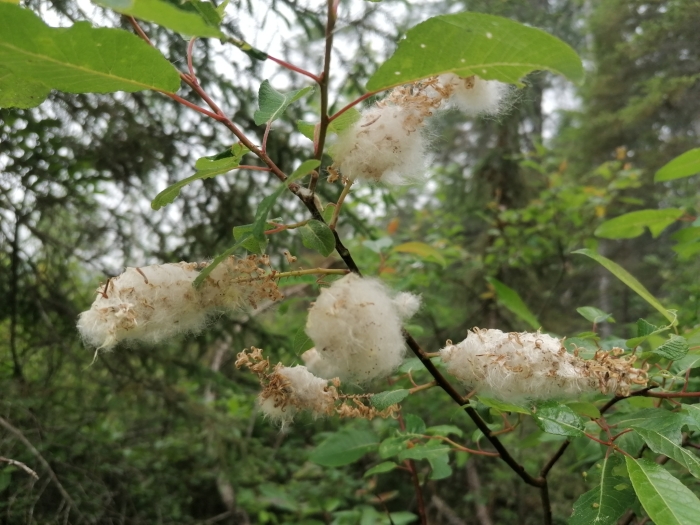Balsam Willow
(Salix pyrifolia)
Balsam Willow (Salix pyrifolia)
/
/

Alexis Williams
CC BY 4.0
Image By:
Alexis Williams
Recorded By:
Copyright:
CC BY 4.0
Copyright Notice:
Photo by: Alexis Williams | License Type: CC BY 4.0 | License URL: http://creativecommons.org/licenses/by/4.0/ | Rights Holder: Alexis Williams | Publisher: iNaturalist | Date Created: 2023-06-25T16:27:40-07:00 |

























Estimated Native Range
Summary
Salix pyrifolia, commonly known as Balsam Willow, is a deciduous shrub native to wetland areas, including swamps, marshes, and along streams and lakes in Canada and the north-central to northeastern United States. It typically grows to a height of 6-12 feet (1.8-3.6 meters) with a similar spread. Balsam Willow is characterized by its narrow, lance-shaped leaves that emit a balsamic fragrance when crushed. It produces catkins in early spring before the leaves emerge, which are not particularly showy but are important for early pollinators.
Balsam Willow is valued for its ability to thrive in wet conditions and is often used for soil stabilization and riparian plantings. It can also be a component of wildlife gardens due to its appeal to birds and beneficial insects. In cultivation, it prefers full sun to part shade and requires consistently moist to wet soil. It is relatively low-maintenance but may require pruning to maintain a desired shape or to remove damaged branches. While not commonly afflicted by serious diseases, willow blight and root rot can occur in poor conditions.CC BY-SA 4.0
Balsam Willow is valued for its ability to thrive in wet conditions and is often used for soil stabilization and riparian plantings. It can also be a component of wildlife gardens due to its appeal to birds and beneficial insects. In cultivation, it prefers full sun to part shade and requires consistently moist to wet soil. It is relatively low-maintenance but may require pruning to maintain a desired shape or to remove damaged branches. While not commonly afflicted by serious diseases, willow blight and root rot can occur in poor conditions.CC BY-SA 4.0
Plant Description
- Plant Type: Shrub, Tree
- Height: 6-20 feet
- Width: 4-12 feet
- Growth Rate: Rapid
- Flower Color: N/A
- Flowering Season: Spring, Summer
- Leaf Retention: Deciduous
Growth Requirements
- Sun: Full Sun
- Water: Medium, High
- Drainage: Fast, Medium, Slow
Common Uses
Erosion Control, Low Maintenance, Water Garden
Natural Habitat
Wetland areas, including swamps, marshes, and along streams and lakes
Other Names
Common Names: Pear-Leaved Willow, Pearleaf Willow
Scientific Names: , Salix pyrifolia, Populus nigra var. plantierensis, Populus ×plantierensis, Salix balsamifera, Salix balsamifera, Salix balsamifera, Salix balsamifera var. alpestris, Salix balsamifera var. lanceolata, Salix balsamifera var. typica
GBIF Accepted Name: